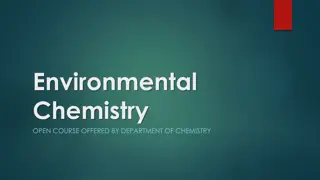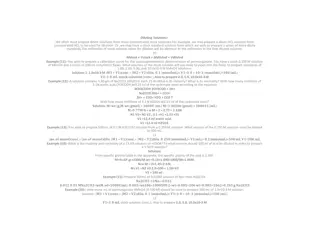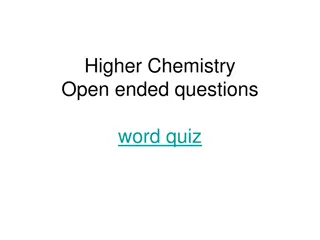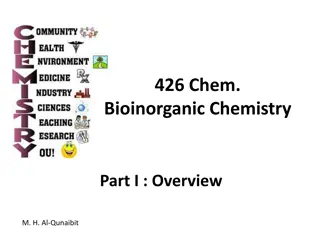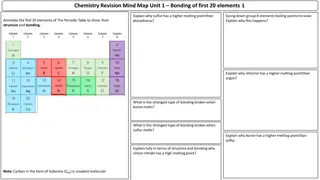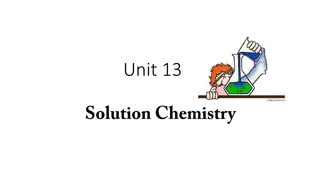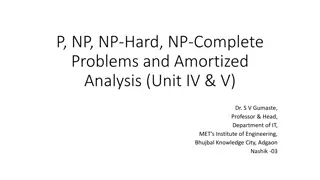Chemistry Practice Problems Solutions Unit 4
The solutions to practice problems in Unit 4 cover topics such as atomic radius comparisons, electron configurations, halogen characteristics, isoelectronic species, and electron behavior in atoms like Na and Ne. Detailed explanations and answers are provided for each question to help understand and apply key concepts in chemistry.
Download Presentation

Please find below an Image/Link to download the presentation.
The content on the website is provided AS IS for your information and personal use only. It may not be sold, licensed, or shared on other websites without obtaining consent from the author.If you encounter any issues during the download, it is possible that the publisher has removed the file from their server.
You are allowed to download the files provided on this website for personal or commercial use, subject to the condition that they are used lawfully. All files are the property of their respective owners.
The content on the website is provided AS IS for your information and personal use only. It may not be sold, licensed, or shared on other websites without obtaining consent from the author.
E N D
Presentation Transcript
Solutions to Practice Problems Unit 4
1. The elements in which of the following have most nearly the same atomic radius? a. Be, B, C, N b. Ne, Ar, Kr, Xe c. Mg, Ca, Sr, Ba d. C, P, Se, I
1. answer Be, B, C, N are in the same period so they have the same number of energy shells. The other choices are in different periods so shells are added as you go down the table. This results in large increases in atomic radius as you go down the groups.
2. ground state electron configuration for the Mn3+ ion? a. 1s22s22p63s23p63d4 b. 1s22s22p63s23p63d54s2 c. 1s22s22p63s23p63d34s1 d. 1s22s22p63s23p63d34s1 Which of the following represents the
2. answer Mn ground state configuration is 1s22s22p6 3s23p63d54s2. If you remove the three highest energy level electrons the 4s come off first, then one of the 3d electrons.
3. the characteristics of the halogens are true EXCEPT a. The first ionization energies (potentials) decrease as the atomic numbers of the halogens increase. b. Fluorine atoms have the smallest radii. c. Iodine liberates free bromine from a solution of bromide ion. d. Fluorine is the most electronegative of the halogens. All of the following statements concerning
3. answer Reactivity decreases down the group for nonmetals. The Activity series shows that I will not replace Br in a rxn.
4. three species isoelectronic? a. S2 , K+, Ca2+ b. Sc, Ti, V2+ c. O2 , S2 , Cl- d. Mg2+, Ca2+, Sr2+ In which of the following groups are the
4. answer S2 , K+, Ca2+all have 18 electrons
5. outermost electron of Na is different than the effective nuclear charge experienced by the outermost electron of Ne. This difference best accounts for which of the following? a. Na has a higher melting point than Ne. b. Na has fewer naturally occurring isotopes than Ne. c. Na has a greater density at standard conditions than Ne. d. Na has a lower first ionization energy than Ne. The effective nuclear charge experienced by the
5. answer Na has a Zeff of 1, while Ne Zeff is 8. Na valence e- requires less energy to remove. Melting point is a function of bonding and IMFs. Isotopes depend on numbers of neutrons. Density is not a function of nuclear charge.
6. average atomic mass of the element represented? a. 10.5 b. 10.2 c. 10.8 d. 10.1 What is the
6. answer 10(0.801) + 11(.0199) = 10.2
7. 35.45 amu. Chlorine consists of two isotopes, 35Cl and 37Cl. Which of the following most closely approximates the relative abundance of these isotopes? a. 25% 35Cl and 75% 37Cl b. 50% 35Cl and 50% 37Cl c. 75% 35Cl and 25% 37Cl d. 90% 35Cl and 10% 37Cl The average atomic mass of a chlorine atom is
7. answer The average is much closer to 35 than 37, so choices a and b are wrong. To determine mathematically: 35(x) + 37(1-x) = 35.45 Solve for x=0.75 and 1-x=0.25
8. kJ/mol. A good estimate for the second ionization energy of magnesium is a. 370 kJ/mol b. 735 kJ/mol c. 1450 kJ/mol d. 6900 kJ/mol The first ionization energy of magnesium is 738
8. answer Successive Ionization energies always increase, so a and b are wrong. Mg has 2 valence e-, so their IEs should be relatively close to each other, which rules out d.
9. generally increases from left to right across the first period of the periodic table? a. As the atomic number increases the electrons are harder to remove. b. ionization energy increases as the atomic number increases in a period. c. as the atomic number increases more electrons are added to the atoms, thus increasing the electron-electron repulsions. d. as the atomic number increases more protons in the nucleus cause an increase in the effective nuclear charge making it harder to remove the electrons. Which of the following is the reason that ionization energy
9. answer Zeff is the explanation or choice when moving across a period. a and b are not reasons, but just statements of trends.e- repulsions are usually more relevant when explaining deviations from the IE trend, like between N and O where IE decreases within and increasing trend. Paired e- in same orbital repel making one e- easier to remove.
10. ionization energy moving from Be to B? a. moving from Be to B, more electrons are added to the atoms, thus increasing the electron-electron repulsions b. moving from Be to B, more protons in the nucleus attract the valence electrons, making it harder to remove the electrons. c. the electrons in Be are being removed from a full subshell, which is more stable than the half-filled subshell in B. d. the electrons in Be are located in the 2s subshell, which is closer to the nucleus and thus harder to remove than the 2p electrons in B. What is the best explanation for the decrease in first
10. answer This example is of two elements in the same period. IE should increase but does not. The additional e- is unpaired so repulsions are not the preferred explanation. Choice b would cause in increase in IE. There is some truth to c, but stability is not one of the favored explanations. d uses distance from the nucleus as an argument. Use terms from Coulomb s law whenever possible.
11. ionization energies of element X in kJ/mol. If Y is a halogen which compound will it make with element X? The table shows the first First IE Second IE Third IE 738 1450 7730 a. XY b. XY2 c. XY3 d. X3Y
11. answer The largest increase in IE is between e- 2 and 3. Therefore, element X has 2 valence e- and would form a 2+ion. Since Y is a halogen it will make a 1-ion and form the XY2compound.
12. group. Which is the correct explanation for this trend? a. the ionization energy decreases as you move down the group, thus it requires less energy to remove the valence electron and results in greater reactivity. b. the greater nuclear charge as you move down the group results in a greater ability to attract electrons to the atom, thus making them more reactive. c. as you move down the group, the nucleus s stability decreases, thus causing an increase in the number of radioactive isotopes, hence an increase in the reactivity of the alkali metals. d. the greater mass as you move down the group causes an increase in the kinetic energy for any given molecule velocity. the increase in kinetic energy accounts for the increase in reactivity. The reactivity of the alkali metals increases going down the
12. answer a. IE does decrease because energy shells are added as you go down the group. Metals lose e- to become more stable. Lower IE makes those e- easier to remove. b. metals do NOT like to attract e- c. isotopes exhibit similar reactivity. nuclear stability affects only radioactivity. d. KE is a function of temperature, not reactivity
13. In which of the following electron transitions for a hydrogen atom does the light emitted have the longest wavelength? a. n=5 to n=2 b. n=4 to n=3 c. n=3 to n=1 d. n=2 to n=1
13. answer The distance between energy levels is proportional to the energy emitted by a photon transitioning between them. The two closest energy levels will result in the lowest energy emission. Energy levels get closer to each other as n increases and they get farther from the nucleus.
14. oxygen. Which of the following correctly describes the relationship between the three values? a. the value for nitrogen is less than that of phosphorus because nitrogen is larger, but greater than that of oxygen because nitrogen has a greater effective nuclear charge b. the value for nitrogen is less than that of phosphorus because nitrogen has fewer protons but greater than that of oxygen because nitrogen has less valence electrons. c. the value for nitrogen is greater than that of phosphorus because nitrogen has less electrons, but less than that of oxygen because nitrogen is smaller. d. the value for nitrogen is greater than that of phosphorus because nitrogen is smaller, but less than that of oxygen because nitrogen has a smaller effective nuclear charge. Nitrogen s electronegativity value is between those of phosphorus and
14. answer a. both statements are false b. both statements also false c. nitrogen is not smaller than oxygen, it is less massive but has a larger radius. Nitrogen does have fewer e- than P, but that would not affect EN. Think about the definition of EN. d. both statements in d are true
15. MJ/mol and the first ionization energy for a neutral atom of argon is 1.52 MJ/mol. How would the first ionization energy value for a neutral atom of potassium compare to those values? a. it would be greater than both because potassium carries a greater nuclear charge than either chlorine or argon. b. it would be greater than both because the size of a potassium atom is smaller than an atom of either chlorine or argon. c. it would be less than both because there are more electrons in potassium, meaning they repel each other more effectively and less energy is needed to remove one. d. it would be less than both because a valence electron of potassium is farther from the nucleus than one of either chlorine or argon. The first ionization energy for a neutral atom of chlorine is 1.25
15. answer a and b are false. c: K has only 1 valence e- and e- repulsion argument is used with paired e- in the same orbital. The explanation of choice when comparing elements in different periods is distance from the nucleus because of the different number of energy shells.
16. Neutral atoms of chlorine are bombarded by high-energy photons, causing the ejection of electrons from the various filled subshells. Electrons originally from which subshell would have the highest velocity after being ejected? a. 1s b. 2p c. 3p d. 3d
16. answer Cl does not have any 3d electrons, so d is incorrect. The highest velocity electrons would be those with highest energy. The 3p electrons are farthest from the nucleus and therefore highest energy
17. A photoelectron spectrum for which of the following atoms would show peaks at exactly three different binding energies? a. c. d. b.
17. answer Three peaks means three different subshells (s, p, d, f) Be is 1s22s2 Ne is 1s22s22p6 Na 1s22s22p63s1 Al is 1s22s22p63s23p15 peaks 2 peaks 3 peaks 4 peaks
18. Which element would have a photoelectron spectra in which the peak representing electrons with the lowest ionization energy would be three times higher than each of all of its other peaks individually? a. carbon b. nitrogen c. neon d. sulfur
18. answer Lowest IE energy peak is farthest from the nucleus. C 1s22s22p2 all peaks same size N 1s22s22p3 lowest IE peak only 50% larger than other peaks Ne 1s22s22p6 6 is 3 times more than 2 S 1s22s22p63s23p4lowest IE peak is only 2 times larger than s peaks, and 50% smaller than the 2p6peak
19. Which of the following represents the first electron affinity of chlorine? a. Cl(g) + e- Cl-(g) b. Cl-(g) + e- Cl-(g) c. Cl(g) Cl-(g) + e- d. Cl2(g) 2Cl-(g)
19. answer Definition of Electron Affinity - energy change when an atom gains an electron
20. Which of the elements above has the smallest ionic radius for its most commonly found ion? a. O b. La c. Rb d. Mg
20.answer a. O2-is an anion, so it is large b. La is a metal in period 6, 6 energy shells, large c. Rb+period 5 d. Mg2+period 3, radius increases down a group
21. Represents an atom that is chemically unreactive a. 1s _ _ 2s _ _ b. 1s _ _ 2s _ _ 2p _ _ _ _ ___ c. 1s _ _ 2s _ _ 2p _ _ _ _ _ _ d. [Ar] 4s _ _ 3d _ _ _ _ _ _ _ _ _ _
21. answer c is a noble gas, it has a full valence shell
22. Represents an atom in an excited state a. 1s ___ 2s _ _ b. 1s _ _ 2s _ _ c. 1s _ _ 2s _ _ 2p _ _ _ _ ___ d. [Ar] 4s _ _ 3d _ _ _ _ _ _ _ _ _ _
22. answer atoms in excited states have empty lower energy orbitals
23. Represents an atom that has four valence electrons a. 1s _ _ 2s _ _ b. 1s _ _ 2s _ _ 2p _ _ _ _ ___ c. 1s _ _ 2s _ _ 2p _ _ _ _ _ _ d. [Ar] 4s _ _ 3d _ _ _ _ _ _ _ _ _ _
23. answer valence electrons are always in the s and p sublevels. b is the only one with 4.
24. Represents an atom of a transition metal a. 1s _ _ 2s _ _ b. 1s _ _ 2s _ _ 2p _ _ _ _ ___ c. 1s _ _ 2s _ _ 2p _ _ _ _ _ _ d. [Ar] 4s _ _ 3d _ _ _ _ _ _ _ _ _ _
24. answer transition metals have d sublevel electrons
25. Which of the following ions has the same number of electrons as Br ? a. K+ b. Sr2+ c. I d. Cl





